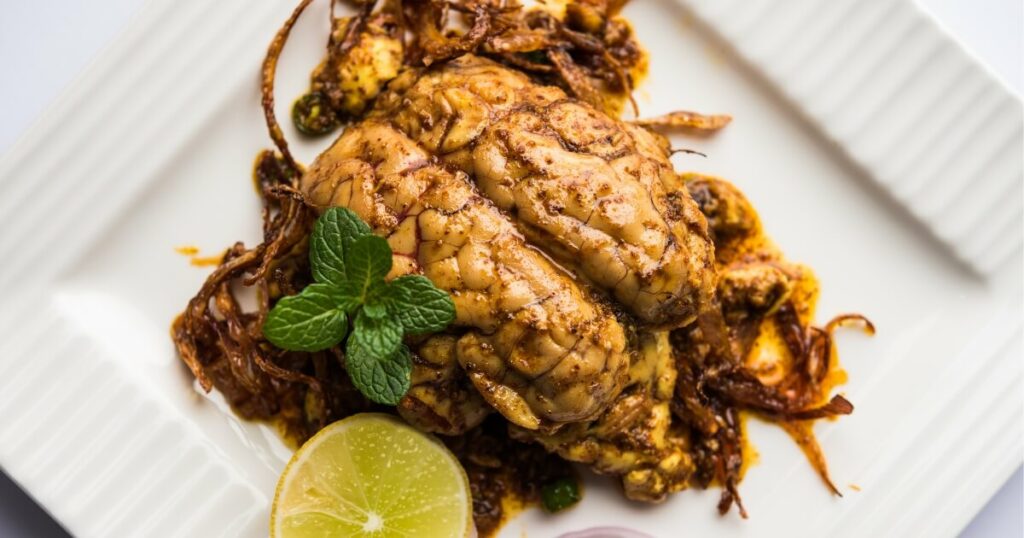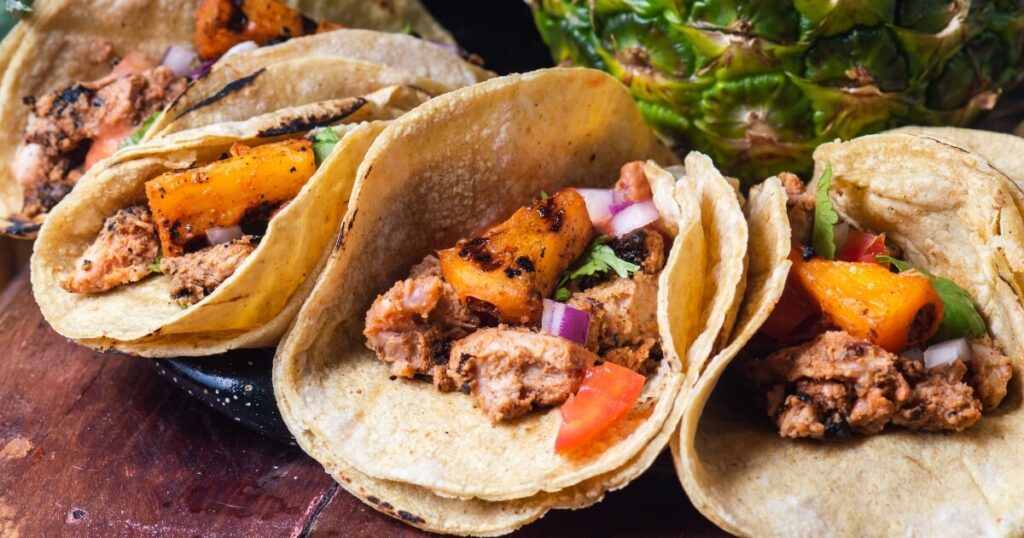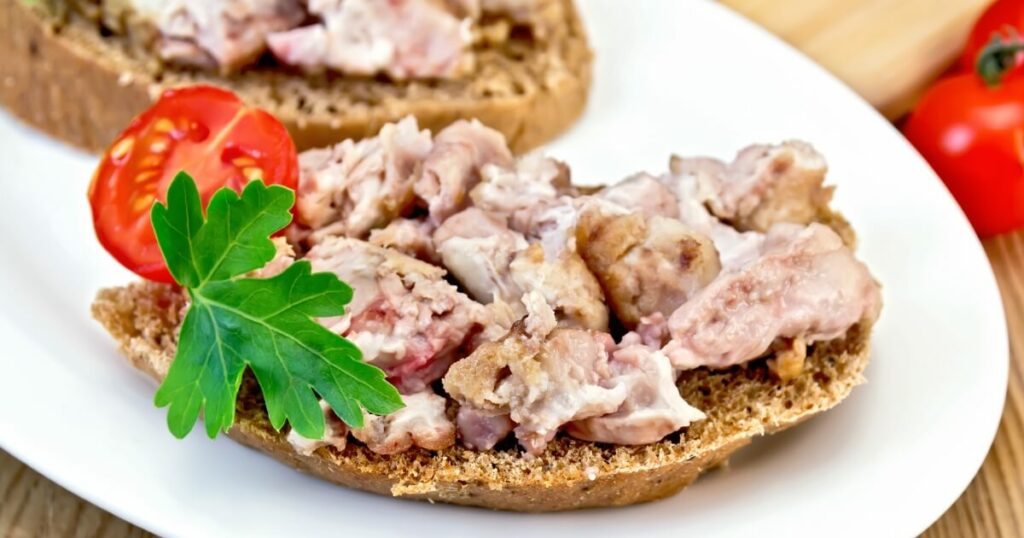Now, you might be scrunching up your nose, thinking, “Brains? Really?” But hold on to your spatula because this is where food gets interesting.
It’s a delicacy often overlooked in many Western cuisines, but it’s rich in nutrients and packed with a flavor profile that’s as intriguing as the organ itself.
So, let’s get into it and talk about the taste of brains from various animals and how you might make them, dare I say, taste good!
How Do Brains Taste?
The taste of brains is a medley of creamy, slightly sweet, and delicately rich flavors, often compared to tofu or a mild chicken liver.

Now, let’s get into the nitty-gritty. When you first bite into a well-cooked brain, the first thing you’ll notice is the texture. It’s incredibly smooth and creamy, almost like a firm custard.
The flavor, on the other hand, is a bit of a surprise. It’s subtly sweet but not in a sugary way. It’s more of a rich, savory sweetness.
The smell of brains is quite mild and doesn’t have the strong, gamey odor that some offal can have. It’s a fresh, almost neutral scent that doesn’t overpower the dish it’s in.
Different Types Of Brains
Interestingly, the taste of brains can vary depending on the animal it comes from.
- Cow Brains: These are among the largest brains and have a slightly firmer texture compared to others. The flavor is more pronounced, making them a good choice for dishes that require a stronger flavor.
- Pig Brains: Pig brains are smaller and have a milder, more delicate taste. They’re used in dishes where the brains are the star of the show, as their subtle flavor shines through.
- Lamb Brains: Lamb’s brains are known for their savory flavor and smooth texture. They’re popular in many Middle Eastern cuisines, usually served in a spicy sauce or curry.
- Goat Brains: Goat brains are similar to lamb brains in terms of flavor and texture. They’re a bit smaller in size and are often used in Indian cuisine, cooked in a variety of flavorful spices.
- Chicken Brains: While not as common as the others, chicken brains are also edible. They’re much smaller and have a delicate flavor that’s best enjoyed in simple preparations.
Are Brains Safe To Eat?
Yes, brains are safe to eat, but like any other food, they need to be sourced, handled, and cooked properly to ensure safety.
One common concern about eating brains is the risk of transmitting diseases. This stems from the infamous “Mad Cow Disease” or Bovine Spongiform Encephalopathy (BSE). This neurodegenerative disease can be transmitted to humans who consume infected cows’ brain or spinal cord tissue.
However, it’s important to note that such cases are extremely rare, especially with today’s stringent food safety regulations, which is why you need to get them from a reputable source.
Another concern is the high cholesterol content in brains. While it’s true that brains are high in cholesterol, they can still be consumed in moderation.
As for misconceptions, some folks might think that eating brains is an odd or even taboo practice. But let’s not forget that food is a reflection of culture, and what might seem unusual in one culture could be a delicacy in another.
What Does Brain Compare With?
- Tofu: The smooth and creamy texture of brains is often compared to tofu. Just like tofu, brains have a subtle flavor that can take on the taste of the ingredients it’s cooked with.
- Chicken Liver: The rich, savory sweetness of brains is somewhat similar to a mild chicken liver. However, brains lack the metallic aftertaste that liver often has.
- Scrambled Eggs: The texture of brains, especially when cooked, can be compared to scrambled eggs. It’s firm yet creamy, making it a delight to eat.
- Pork: Some people find the taste of brains to be somewhat similar to pork, especially when it’s cooked with herbs and spices.
- Kidneys: The taste of brains has also been likened to kidneys, although brains have a much smoother texture and a more delicate flavor.
Does Brain Taste Good?
Well, if you’re someone who prefers more familiar, meaty textures, the creaminess of brains might be a bit out of your comfort zone. It’s not your typical chewy or firm meat, and this might take some getting used to.
Flavor-wise, brains have a mild taste that can meld with a variety of spices and herbs. This can be a plus for those who love to experiment with flavors.
However, if you prefer strong, distinct flavors, the subtlety of brains might seem a bit bland.
Ultimately, whether brains taste good or not is a matter of personal preference. But hey, isn’t that the beauty of food?
How To Eat Brains
Here are a few popular methods of preparation that highlight the unique taste and texture of brains.
Brain Tacos

Brain tacos, or “tacos de sesos,” are quite popular in Mexican cuisine. The brains are usually boiled, then pan-fried until they’re slightly crispy on the outside but still creamy on the inside.
They’re then served on a warm tortilla with a sprinkle of cilantro, onions, and a squeeze of lime. The contrast of the crispy, creamy brains with the fresh toppings makes for a delightful bite.
Brain Curry

In Indian cuisine, brain curry or “bheja fry” is a delicacy. The brains are cooked in a spicy, aromatic blend of spices, onions, tomatoes, and herbs. The brains’ mild taste beautifully absorbs the curry’s bold flavors, making it a rich and flavorful dish.
Pan-Fried Brains
A simple yet delicious way to enjoy brains is to pan-fry them. After blanching and cleaning the brains, they’re lightly coated in flour and then pan-fried in butter until golden brown.
The result is a dish that’s crispy on the outside, creamy on the inside, and absolutely delicious. It’s often served with a squeeze of lemon and a side of fresh salad.
Brain Sandwich

The brain sandwich is a regional favorite in parts of the United States, particularly in the Midwest. Slices of calf brain are breaded and deep-fried, then served on a bun with pickles, onions, and mustard. The crispy, fried brains paired with the tangy pickles and onions make for a unique and tasty sandwich.
What Do Brains Look Like?
In their raw form, brains are a soft, jelly-like organ that’s covered in a thin membrane. They’re usually a pale pinkish-white color with a smooth, glossy surface.

The brain is made up of two hemispheres, each with its own intricate pattern of folds and crevices. This pattern, known as the brain’s “gyri” and “sulci,” gives the brain its characteristic wrinkled appearance.
When it comes to texture, raw brains are quite delicate and squishy to the touch. They’re very soft, almost like a firm gelatin, and must be handled carefully to avoid damaging them.
Once cooked, the color of brains changes to a more opaque white or light beige. The texture becomes firmer but still retains its creaminess.
Depending on the method of cooking, the outside of the brains can become slightly crispy or golden brown, while the inside remains smooth and creamy.
Brain FAQs
Can You Eat Animal Brains?
Absolutely! Animal brains are not only edible but are considered a delicacy in many cultures around the world. They’re often used in a variety of dishes, from tacos to curries, and offer a unique taste and texture that’s quite unlike any other ingredient.
Is It Safe To Eat Cow Brains?
Yes, it is safe to eat cow brains, provided they are sourced from a reliable place and cooked properly. However, due to concerns related to Bovine Spongiform Encephalopathy (BSE), certain precautions are recommended.
What Are Brains Called In Cooking?
In culinary terms, brains are often referred to as “offal,” a term that encompasses all the internal organs and entrails of a butchered animal. You might also hear them referred to as “variety meats” or “organ meats.”


